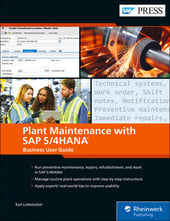Companies such as utilities firms that have large, fixed assets on their balance sheets know it’s important to keep them maintained and free from downtime.
In the world of SAP, the SAP for Utilities and SAP S/4HANA Utilities solutions are industry-specific offerings for companies providing services such as water, electricity, heat, waste removal, etc. It consists of a bundle of existing SAP products, such as SAP CRM and SAP Billing and Revenue Innovation Management, that provides companies with ways to manage customer information, read meters and other measurement devices, bill for services provided, and more. It also includes helpful asset management tools.
This is important as these types of companies have a large network of assets that are continuously used and must be in top shape to ensure services are delivered to customers. In order to make sure that these assets are able to complete their jobs, companies utilize a set of strategies to maintain these assets.
What is Asset Management?
The term “asset management” is generically defined as work that focuses around the maintenance of a business’ fixed assets—things like manufacturing components, vehicles, plants, etc. Examples include replacing broken infrastructure on the manufacturing floor, determining a downtime schedule to inspect or completely replace components when their lives have been completed, and renovating or building new plants to increase production efficiency.
While all of these tasks require some type of manual work, the proliferation of business software beginning in the 1980s brought about improvements to the world of asset management. Rather than keep tabs of fixed assets by hand in a ledger, businesses could now keep track of things on a computer. The later advent of sensors meant that businesses could monitor asset use in real time, predict when issues may arise, and proactively manage their maintenance.
SAP has long been a part of the asset management space. Its legacy suite, SAP ERP, includes functionality under the product name SAP Enterprise Asset Management (commonly referred to as SAP Plant Maintenance or SAP PM). This allowed users to perform inspections, preventative maintenance, and repairs—important tasks that those in the utilities industry would need to regularly perform.
While those running SAP for Utilities with their SAP ERP system likely have a handle on how to maintain their infrastructure, it’s important for those running the new suite to learn how it can affect asset management processes.
What is SAP S/4HANA Asset Management?
Shortly after SAP released its new business suite, SAP S/4HANA, in 2015, the company announced that the equivalent to SAP PM would fall under a line of business (LoB) called SAP S/4HANA Asset Management.
This LoB includes functionality for a handful of different tasks. For one, it improves maintenance execution by utilizing real-time data so a plant foreman can quickly troubleshoot issues. It also helps keep tabs on important safety information such as incident rate and OSHA requirements. Lastly, it can help reduce downtime by scheduling planned maintenance and inspections.
SAP S/4HANA Asset Management for Utilities
For companies running SAP S/4HANA Utilities, asset management can be performed with SAP S/4HANA Asset Management. Let’s take a look at some relevant use cases that would be beneficial for stakeholders to know.
Equipment Calibration
Prior to starting up a new piece of machinery for the first time, it’s important to put it through its paces to make sure it’s ready for the task. Equipment calibration functionality allows companies such as water utilities to test pumps and pipes, and heating utilities such as gas companies to ensure pressure sensors and emergency cutoff devices are working properly.
Status Management
For companies that deliver services via a network of cables, such as electric utilities, SAP S/4HANA Asset Management provides ways to ensure that those components are running the way they should. Managing the status with SAP Fiori apps (more on these below) means foremen can have relevant information at their fingertips via a mobile device. If something goes wrong, they’ll be alerted right away and can dispatch help to wherever the issue occurred.
Preventive Maintenance
Even the best-oiled machine needs a tune up from time to time. SAP S/4HANA Asset Management’s preventive maintenance functionality provides users with the tools needed to schedule and perform preventive maintenance activities. For example, a waste removal company may have its vehicle fleet on a staggered tune up schedule so all vehicles are regularly checked for engine wear and hydraulic line issues. This helps reduce the risk of surprises down the road.
SAP Fiori Applications
The default SAP S/4HANA user interface is SAP Fiori, and with it comes a whole host of applications that make asset management tasks easier. One such example is the Maintenance Planning Overview app, which allows maintenance planners the ability to check unprocessed maintenance requests, POs, and other relevant metrics. Another helpful SAP Fiori app is the Maintenance Scheduling Board app.
(You can find all SAP Fiori apps via this SAP library.)
Conclusion
It’s crucial that utility firms keep their infrastructure and assets running in order to meet customer expectations. With a solid asset management strategy this can be possible, avoiding costly lapses in service and negative customer sentiment. For those using SAP S/4HANA as their ERP solution, the SAP S/4HANA Asset Management LoB is perfectly tailored for such operations.
Want to learn more about asset management with SAP? Check out our list of books for both SAP ERP and SAP S/4HANA systems here.
This post was originally published 9/2020.



Comments